
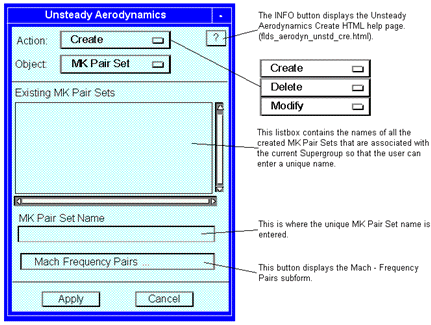
Note: | 1. The user is able to create duplicates of already existing Mach - Frequency Pair Sets. This can be done by selecting an existing name from the “Existing MK Pair Sets” listbox. This name is entered into the “MK Pair Set Name” databox and the data for this selection is displayed on the “Mach - Frequency Pairs” subform. The name needs to be changed before the “Apply” button is selected otherwise an error message is generated. 2. Selecting “Apply” associates the “Mach - Frequency Pairs” with the “MK Pair Set Name” and stores the data in the database in association with the current Supergroup. |
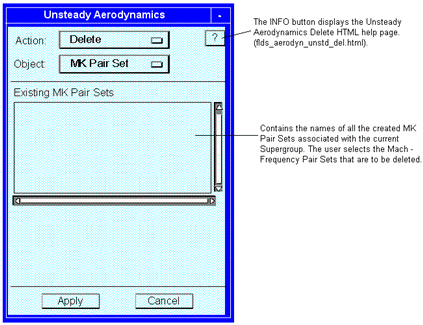
Note: | 1. The user can select any number of Mach - Frequency Pair Sets to be deleted. 2. Selecting “Apply” deletes the “Mach - Frequency Pairs” data and the “MK Pair Set Name” from the database and disassociates it from the current Supergroup. |

Note: | 1. The user selects an existing name from the “Existing MK Pair Sets” listbox. This name is entered into the “New MK Pair Set Name” databox and the data for this selection is displayed on the “Mach - Frequency Pairs” subform. 2. This form can also be used to change the name of the “MK Pair Set”. If the name in the “New MK Pair Set Name” databox is different than the selected name in the “Existing MK Pair Sets” listbox, then the new name is associated with the new “Mach - Frequency Pairs” data in the database and the old name/data are deleted. 3. Selecting “Apply” modifies the “Mach - Frequency Pairs” data that is associated with the selected “MK Pair Set Name” and restores the data in the database in association with the current Supergroup. |
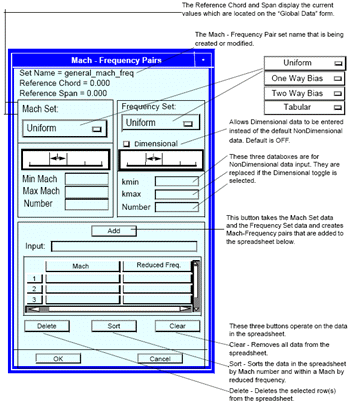
Note: | 1. This form is valid for both the Create action and the Modify action. If an existing MK Pair Set is selected, then the data associated with that Mach - Frequency Pair is displayed in the spreadsheet. If this is a modify action, these data can be modified. 2. This form should not be displayed if the “Reference Chord” and the “Reference Span” widgets on the “Global Data” form have not already been defined. A message to direct the user should be issued. 3. M = Mach, k = Reduced Frequency, F = Cyclic Frequency, and V = Velocity. 4. The “Min Mach”, “Max Mach”, “kmin”, and “kmax” databoxes are all of type Real and blank by default. 5. The two “Number” databoxes are both of type Integer and are blank by default. 6. The spreadsheet has 20 rows to start. When the “Add” button is selected, the data entered above is transferred into the spreadsheet below any rows that are already filled in. If there are not enough rows in the spreadsheet to hold the new data the “Add” button causes new rows to be created. 7. When the “OK” button is selected, all the information that is currently in the spreadsheet is stored in the database. This data is to be stored in the same way that the “Trim Parameter” data for the “Static Aeroelasticity” solution type is currently being stored. 8. The “Mach Set” option menu and the “Frequency Set” option menu work independent of one another so they do not have to be set to the same values. 9. If only 1M or 1k is desired Min or Max Uniform with 1 should be allowed. 10. Must have at least 1 Mk pair at the time the OK button is selected. 11. The data from this form is used with the MKAERO1 card. 12. The user should be able to cycle the Mach set and Freq. Set and press the “Add” button multiple times - thereby accumulating pairs. |
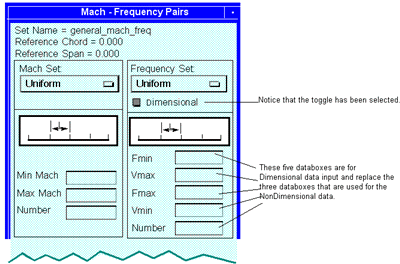
Note: | 1. F = Cyclic Frequency and V = Velocity. 2. The “Min Mach”, “Max Mach”, “Fmin”, “Vmax”, “Fmax”, and “Vmin” databoxes are all of type Real and blank by default. 3. The two “Number” databoxes are both of type Integer and are blank by default. |
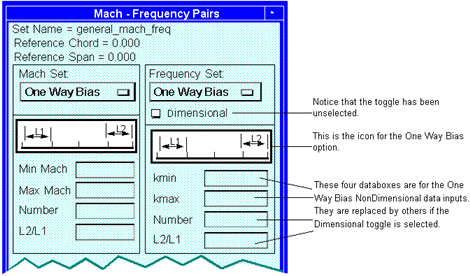
Note: | 1. This form is valid for both the “One Way Bias” and the “Two Way Bias” option. The only difference between the two forms is the icon. For the “Two Way Bias” option the icon looks like this: 2. k = Reduced Frequency. 3. The “Min Mach”, “Max Mach”, “kmin”, “kmax”, and the two “L2/L1” databoxes are all of type Real and blank by default. 4. The two “Number” databoxes are both of type Integer and are blank by default. 5. These icons are the same ones that are used on the “Mesh Control” forms. |
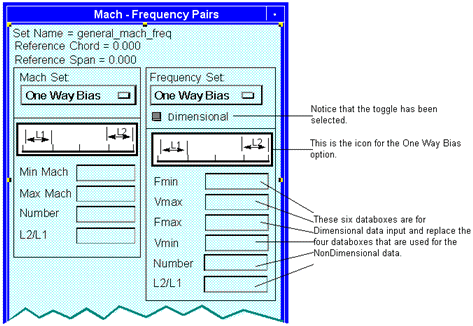
Note: | 1. This form is valid for both the “One Way Bias” and the “Two Way Bias” option. The only difference between the two forms is the icon. For the “Two Way Bias” option the icon looks like this: 2. F = Cyclic Frequency and V = Velocity. 3. The “Min Mach”, “Max Mach”, “Fmin”, “Vmax”, “Fmax”, “Vmin”, and the two “L2/L1” databoxes are all of type Real and blank by default. 4. The two “Number” databoxes are both of type Integer and are blank by default. 5. These icons are the same ones that are used on the “Mesh Control” forms. |
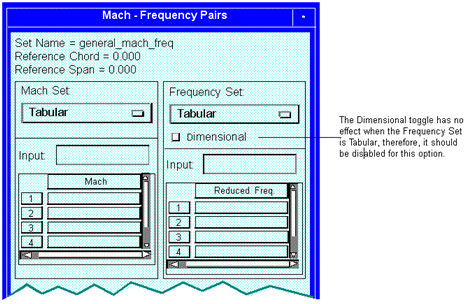
Note: | 1. There are 25 rows in each spreadsheet. 2. The user enters the data (a real number) in the “Input” databox and presses the Return/Enter key to store the data in the “Mach” or “Reduced Freq.” spreadsheet. 3. The user deletes the data in the “Input” databox and presses the Return/Enter key to remove data from the selected cell. |